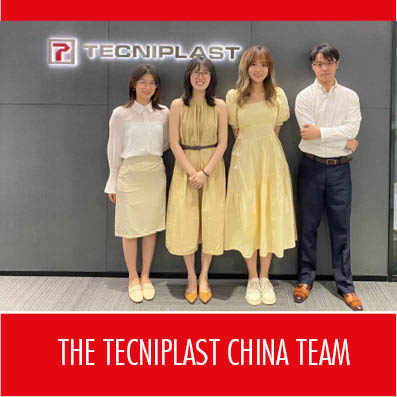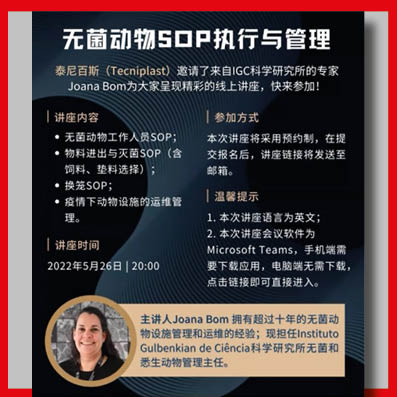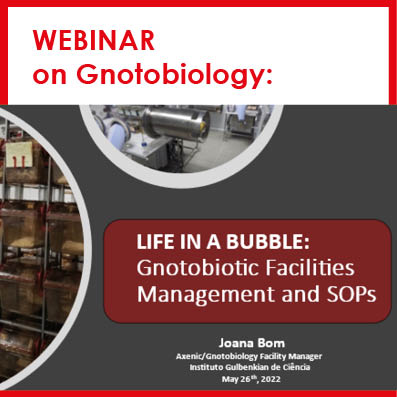
The current version of the Tecniplast website doesn't match your region. Please visit your local website to find information and offerings specific to your country.

The current version of the Tecniplast website doesn't match your region. Please visit your local website to find information and offerings specific to your country.

 TECNIPLAST CHINA has recently organized an interesting Webinar on Gnotobiology with the contribution of Joana Bom, Axenic/Gnotobiology and Mouse Facility Manager
TECNIPLAST CHINA has recently organized an interesting Webinar on Gnotobiology with the contribution of Joana Bom, Axenic/Gnotobiology and Mouse Facility Manager
A four-handed interview with Chenyan Lu, Marketing Manager Tecniplast China and Joana Bom, Gnotobiotic expert at Instituto Gulbenkian de Ciência, Portugal, on the successful webinar held on May 2022.
The Tecniplast China team has done a good job, reaching almost 200 participants!
Chenyan, how do you see the Gnotobiology trends in China?
Just as Gnotobiology experimentation has become a highly specialized field, the specialties for GF assistants continue to multiply.
Meanwhile we did not see a clear growth trend in the Gnotobiology during Covid period, but instead a remarkable increase in of ABSL-3 & ABSL-4 experiments has been recorded in the last two years.
 Joana Bom has made a fantastic presentation. Which session do you think was most successful in the mind of TP China Customers and why?
Joana Bom has made a fantastic presentation. Which session do you think was most successful in the mind of TP China Customers and why?
We enjoyed nearly 2hrs of feast cooked by Chef Joana. From which we have experienced not only authority in theory but also hands-on knowledge. Since Gnotobiology is still an emerging area for the LAS community in China, every word from Joana was valued.
Dear Joana, how do you see Gnotobiology trends in China and how do they compare with European trends? Do you see any similarities in specific evolutions?
Gnotobiology in China has started recently, but these last few years I have seen an exponential growth and development. The evolution is for sure different, as Chinese facilities can learn or take advantage of the learning curve that all the facilities in Europe have experienced for decades. The equipment and technologies available now are also different from 20 years ago and facilitates the everyday workload. For years, facilitate have performed gnotobiotic experiments using Isolators, clearly sub-optimal for specific procedures (e.g delicate surgeries, or repeated sample collections). Nowadays, recent technologies like the positive pressured individual ventilated cages (ISOCage P System) facilitate the work of those performing experiments with axenic animals, by allowing cage and animal manipulation under an axenic environment on a dedicated biosafety station.
The combined use of both isolators and ISOcages do allow for a rapid growth and evolution of gnotobiology facilities, and the research outcomes that may arise from that.
I am optimistic on this evolution.
 Which topics were the most interesting to the Audience?
Which topics were the most interesting to the Audience?
My presentation was related to management and technical procedures, so the focus of the questions was technical.
I received questions about contaminations, but especially about the microbiology screening performed on the animals to ensure the axenic status. These may be the most frequent questions I receive, and it is normal. When you start a facility and must establish SOPs, and choose the way you will manage the service, it is particularly important to make sure contaminations are known, accepted, avoided, but also solved in a methodical way. Maintaining the animals germ-free is the most challenging task of keeping a gnotobiotic facility running, proving that high standard of quality is always kept.
Other questions were related to specific projects that we have developed in my facility. I have shared results of a cancer research performed with a Germ-free mutant strain that mimics a spontaneous mammary gland tumor.
THE TECNIPLAST CHINA MARKETING TEAM